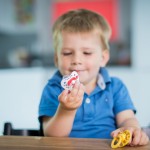
A soother can be used to satisfy a baby’s need to suck. However, it should never be used instead of feeding, and it should never be used without the extra comfort and cuddling a parent can provide. If your baby seems to want to suck in between feedings, a soother can help.
WHAT ARE THE ADVANTAGES?
- Proper use of soothers encourages oral development.
- Sucking on a soother is better than a thumb or finger because it causes fewer problems with hygiene and future tooth development.
- A parent can control the use of soothers, but it’s harder to control thumb sucking. When it’s time to stop using a soother, you can throw it away. You can’t throw away a thumb!
- Also, the latest medical research finds that using a soother may decrease the risk of sudden infant death syndrome (SIDS) or crib death.
THE DO’S AND DON’TS OF SOOTHERS
- Never start using a soother until breastfeeding is fully established. Talk to your doctor or lactation specialist if you feel your baby needs to use one at this early stage. An exception is for premature or sick babies in the hospital. They may use one for comfort.
- Never give your baby a soother instead of feeding.
- Always see if your baby is hungry, tired or bored before giving him the soother. Try solving these things first.
- Always sterilize the soother by putting it in boiling water for 5 min before the first use. Make sure it’s completely cooled down before giving it to your baby. Then, keep it clean by washing it with hot, soapy water after each use.
- Always check for cracks or tears before giving a soother to your baby. Sometimes, parents give their baby a soother right after giving a medicine (like a pain reliever, antibiotics or vitamins); some of these medicines can cause the material in the soother to break down. If there are cracks or tears, throw it out. Replace the soother every two months, before damage occurs.
- Never dip the soother in sugar or honey. This will damage the teeth. Honey can lead to botulism, which is a type of food poisoning.
- Never tie a soother around a baby’s neck. This can cause strangulation and death. Instead, you can use clips with short ribbons attached to them. These are available where you buy soothers and are safe to use.
- Never make your own soother out of bottle nipples, caps or other materials. These can cause choking and death.
- Never let your older child crawl or walk around with a soother all day long. This may interfere with speech development and may cause problems with their teeth.
- Never let your baby or child chew on a soother. It could break down and cause choking and death.
TIPS ON GETTING YOUR CHILD TO STOP USING A SOOTHER
- Limit the time you allow your child to use a soother.
- Never use punishment or humiliation to force your child to give up using a soother.
- Involve your child in the decision to stop using it by giving him the choice of throwing it away, putting it away or leaving it under the pillow for the ‘tooth fairy’.
- Start a reward chart to mark your child’s progress.
- Praise your child when your child has given up the soother and tell her you are proud that she is growing up.
- Allow your child to express his feelings and if your child is upset or angry, give him special cuddles to help him cope.

